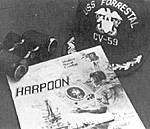 HARPOON is a new set of rules for modern tactical naval
warfare, authored by Lawrence Bond and published by Adventure
Games. The booklet is professionally printed in an 8.5x11 inch format,
57 pages long. The actual rules of play take only about 15 pages and
are rather short and concise. There are 18 pages of ship data
(approx. 140 modern vessels), 4 pages of aircraft characteristics
(over 70 aircraft) and additional tables with data for guns, missiles,
sensors and ASW weapons (rules cover submarines and ASW).
HARPOON is a new set of rules for modern tactical naval
warfare, authored by Lawrence Bond and published by Adventure
Games. The booklet is professionally printed in an 8.5x11 inch format,
57 pages long. The actual rules of play take only about 15 pages and
are rather short and concise. There are 18 pages of ship data
(approx. 140 modern vessels), 4 pages of aircraft characteristics
(over 70 aircraft) and additional tables with data for guns, missiles,
sensors and ASW weapons (rules cover submarines and ASW).
The distance scale of one inch per one thousand Yards and time scale of thirty seconds per turn are intended to be used with 1:3000 or 1:2400 scale ships. The rules could be adapted for use with 1:1200 modern ships, but the distance scale should be modified (perhaps one inch per 500 yards). The combat system is based on dice not range estimation. A turn consists of five phases: plotting, movement, planned fire, detection and reaction fire with the players executing their operations simultaneously. The detection and reaction fire phases give the game the modern flavor by involving sensors, target acquisition, fire control, etc.
Although there are no specific rules or procedures for electronic countermeasures (ECM) or electronic counter-countermeasures (ECCM), the way in which a player uses the planned fire phase and reaction fire phase gives a kind of abstraction of the influence of the ECM, ECCM functions. There are provisions for electronic support measures (ESM) during the detection phase in the sense of identifYing, locating and classifying contacts. Players can choose to use active or passive sensor modes and receive the benefits or suffer the consequences of an inappropriate choice. A player can also be caught with his fire control in the wrong mode . . . surface when he has aircraft targets, or vice versa.
The rules work well and are relatively simple . . . about the level of conplexity of GENERAL QUARTERS, not as complete and detailed as WARSHIP COMMANDER. The rules start with a sample two-ship action and comments. There are good explanations for procedures and there are usually numerical examples to illustrate a technique. Ranges (of weapons and sensors) are more critical and "bothersome" in a game of this era than in a WWII-type game. There are ranges for the various types of radars and the variety of surface and other weapons which come into play against ships, missiles and aircraft. Every gun, missile or sensor has several characteristic ranges which need to be tabulated (e.g., range of detection for small targets, for large targets, range at which it may be detected by ESM, etc.) One DDC I used (PRC's LUTA) had 18 characteristic ranges.
The HARPOON rule booklet contains sample forms for ships, aircraft and a log sheet. I recommend, in addition, drawing up a list of ranges, in numerical sequence, for use in each scenario. Such a list for each side will save alot of thumbing through tables or checking through ship and aircraft characteristics. If each of the ranges is on a card (with two or three cards per system) the cards can be rearranged and reassembled over a number of games without having to rewrite the characteristics each time. Only the sensors or weapons which have not been used in a previous scenario need to be put on cards in order to play a new scenario.
The rules are clear and unambiguous. An experienced player can read them and be playing in an hour or so. A new player can be introduced to the rules in the space of three or four turns. I recommend HARPOON for anyone with an interest in contemporary naval wargaming. The price is $7.95 from Adventure Games, Inc., 871 Edgerton St., St. Paul, MN 55101 or your local dealer.
More Reviews
-
Leviathan: 25mm Romans (figures)
GHQ: Modern MicroArmor (1/285th scale figures)
Harpoon Modern Naval Combat (rules)
Armies and Enemies of Imperial Rome (book)
Navies of the Napoleonic Era (book)
System 7 Napoleonics (rules)
Back to Table of Contents -- Courier Vol. III #1
To Courier List of Issues
To MagWeb Master Magazine List
© Copyright 1981 by The Courier Publishing Company.
This article appears in MagWeb (Magazine Web) on the Internet World Wide Web.
Other military history articles and gaming articles are available at http://www.magweb.com